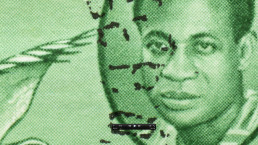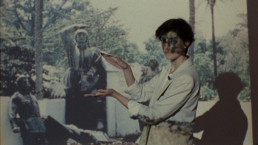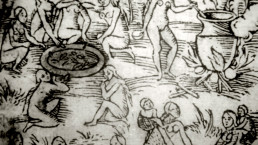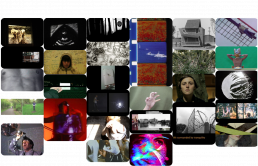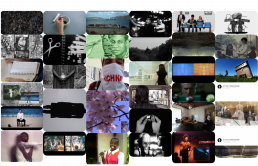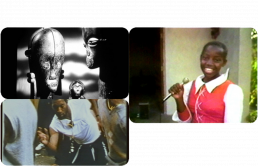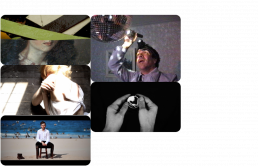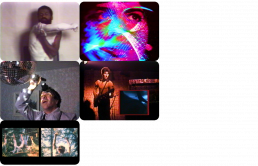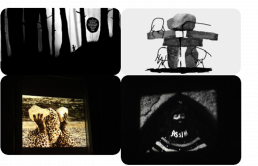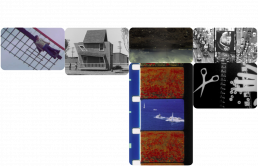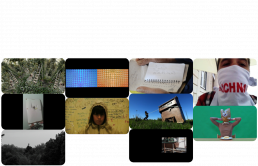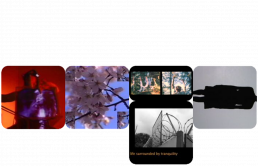“FUSO 2016 – 23 a 28 de Agosto“
Programa
Agosto 25, 23h15
Museu Nacional de Arte Contemporânea (MNAC) – Museu do Chiado
A Redistribuição de Poder
Curatorship by Bruno Leitão
Total running time 73’
O filme ensaio pode ser uma das mais importantes testemunhas da redistribuição de poder e pode-se também argumentar que é uma das formas artísticas que mais efetividade terá em provocar algum tipo de impacto social e político. Em três perspetivas de The Otolith Group, Filipa César e Pedro Neves Marques sobre cultura e narrativas de poder, exibem-se argumentos sobre o poder político da ideia transformada em texto, manifesto, escultura e selo.
O selo aqui aparece como uma forma de monumento, não é uma forma artística que questione algo, em vez disso é uma forma de veicular uma ideia, o legado de um herói, a diversidade da fauna de determinado país ou de um momento histórico e mudança política, tendo a particularidade de ser sempre originado dentro do contexto de um estado-nação, pertencendo-lhe assim a respetiva propriedade intelectual, tendo a função de ser uma das mais antigas formas de propaganda política e política externa ao serviço de um país.
Se o vídeo de The Otolith Group analisa a forma como se suprimiram momentos da História das independências em África em determinados momentos, já o vídeo de Filipa César indaga sobre necessidade de reavaliar a estatuária e a dificuldade de um povo enfrentar a sua própria história.
Já o vídeo-ensaio de Pedro Neves Marques faz a ligação entre o Manifesto Antropofágico de Oswaldo de Andrade e a possibilidade de uma epistemologia do Sul aplicada a noções de ecologia, cibernética, economia, produção e consumo forçando neste caso uma inversão dos papéis dentro da história de imperialismo cultural no contexto Norte/Sul.
The Otolith Group, In the Year of the Quiet Sun, 2013, 33’57’’
In the Year of the Quiet Sun (2013) toma o seu nome do decréscimo da temperatura da superfície solar que ocorre a cada onze anos. Desde Novembro de 1964 a Novembro de 1965, os estados-nação do mundo editaram selos para comemorar a primeira expedição científica a estudar o sol. À medida que os selos iam girando a sua atenção para o céu, iam também ignorando a situação instável dos novos estados independentes de África.
Filipa César, Cacheu, 2012, 10’20’’
Cacheu é uma filmagem de 10 minutos de uma palestra, com performance de Joana Barrios, que gira em torno de quatro estátuas coloniais, que estão hoje armazenadas no Forte de Cacheu, um dos primeiros bastiões construídos pelos portugueses em 1588, a fim de facilitar o comércio de escravos na Guiné-Bissau.
Barrios evoca conflitos simbólicos, traçando diferentes contextos em que as estátuas apareceram: num pedestal durante o colonialismo Português, destronadas e partidas em pedaços após a independência no filme Sans Soleil de Chris Marker, como fantasmas de fundo em MortuNega de Flora Gomes, e finalmente exibidas no Forte de Cacheu. A montagem é um processo que ocorre antes das filmagens, para que a produção de imagens seja resultado de uma assemblage performativa entre texto, ação, imagem projetada e o enquadramento da câmara pelo diretor de fotografia, Matthias Biber.
Realização, Argumento e Produção Filipa César
Performance Joana Barrios
Fotografia Matthias Biber
Som Nuno da Luz
Assistência de Produção Diana Artus, Jorge Biague, Joaquim Gomes e Rita Pestana
Filmado como performance ao vivo no contexto do congresso What Happened 2081?, com curadoria de Georg Diez e Christopher Roth, Kunstwerke, Berlim
Pedro Neves Marques, Where to Sit at the Dinner Table, 2013, 28′
Este filme-ensaio, de tom especulativo, narra a relação entre teorias ecológicas, cibernéticas, e económicas, através de noções de crescimento, consumo e energia solar. Estas reflexões são intercaladas com contos sobre rituais canibais no Brasil no início do século XVI, cujo imaginário define os elementos visuais do filme, sejam eles microfilmes de livros e gravuras, ou material museológico e gráfico sobre cosmologias ameríndias.
Argumento, Realização e Produção Pedro Neves Marques
Com o generoso apoio do Centro Cultural Montehermoso, Espanha, e a Biblioteca Nacional do Rio de Janeiro, Brasil
“FUSO 2016 – August 23 to 28“
Program
August 25, 11:15pm
Museu Nacional de Arte Contemporânea (MNAC) – Museu do Chiado
A Redistribuição de Poder
Curatorship by Bruno Leitão
Total running time 73’
The film essay may be one of the most important testimonies to the redistribution of power and it is arguably one of the art forms most effective in provoking some kind of social and political impact. These three perspectives from The Otolith Group, Filipa César Neves and Pedro Marques on culture and narratives of power expose arguments about the political power of the idea transformed into text, manifesto, sculpture and stamp.
The stamp appears here as a form of monument, is not an art form to question something, rather it is a way to convey an idea, legacy of a hero, the diversity of a country’s fauna or a historic moment and political change, it has the peculiarity of always originating within the context of a nation-state, belonging to it as does the intellectual property and having the function of being one of the oldest forms of political propaganda and foreign policy at service of a country.
If The Otolith Group’s video analyses the form in which moments of history of independence in Africa were deleted at certain times, the video of Filipa César inquiries about the need to reassess the statuary and the difficulty of a people in facing their own history.
The video essay of Pedro Neves Marques connects the Anthropophagic Manifesto by Oswaldo de Andrade and the possibility of an epistemology of the South applied to notions of ecology, cybernetics, economy, production and consumption forcing a reversal of roles within the history of cultural imperialism in the North/South context.
The Otolith Group, In the Year of the Quiet Sun, 2013, 33’57’’
In the Year of the Quiet Sun (2013) takes its name from the decrease in solar surface temperature that occurs every eleven years. From November 1964 to November 1965, the nation states of the world issued postage stamps to commemorate the first scientific expedition to study the sun. As the stamps turned their face towards the sky, they overlooked the unstable land of Africa’s newly independent states.
Filipa César, Cacheu, 2012, 10’20’’
Cacheu is a 10-minute shot of a lecture, performed by Joana Barrios, revolving around four colonial statues, which are stored today at the Fortress of Cacheu, one of the first bastions constructed by the Portuguese in 1588 in order to facilitate slave trade in the West African country of Guinea Bissau.
Barrios evokes symbolic conflicts by tracing back different contexts in which the statues make an appearance: on a pedestal during Portuguese colonialism, dethroned and broken in pieces after Independence in the film Sans Soleil by Chris Marker, as background ghosts in MortuNega by Flora Gomes, and finally displayed at the Cacheu fort. The montage is a process that takes place before shooting, so that the image production is a result of a performative assemblage between text, acting, projected image and the framing of the camera by the director of photography, Matthias Biber.
Directing, Script and Production Filipa César
Performance Joana Barrios
Cinematography Matthias Biber
Sound Nuno da Luz
Production assistance Diana Artus, Jorge Biague, Joaquim Gomes and Rita Pestana
Filmed as a live performance in the context of the congress What Happened 2081?, curated by Georg Diez and Christopher Roth, Kunstwerke, Berlin
Pedro Neves Marques, Where to Sit at the Dinner Table, 2013, 28′
Speculative in tone, this film-essay narrates the relationship between ecological theories, cybernetics, and economics, through notions of growth, consumption, and solar energy. These reflections are intercalated with tales about cannibal rituals in Brazil in the early sixteenth century, whose imaginary defines the film’s visuals, be it microfilms of books and etchings, or museological and graphic material on Amerindian cosmologies.
Script, Directing and Production Pedro Neves Marques
With the generous support of Centro Cultural Montehermoso, Spain, and the National Library of Rio de Janeiro, Brazil
